Preview table of contents and sample page
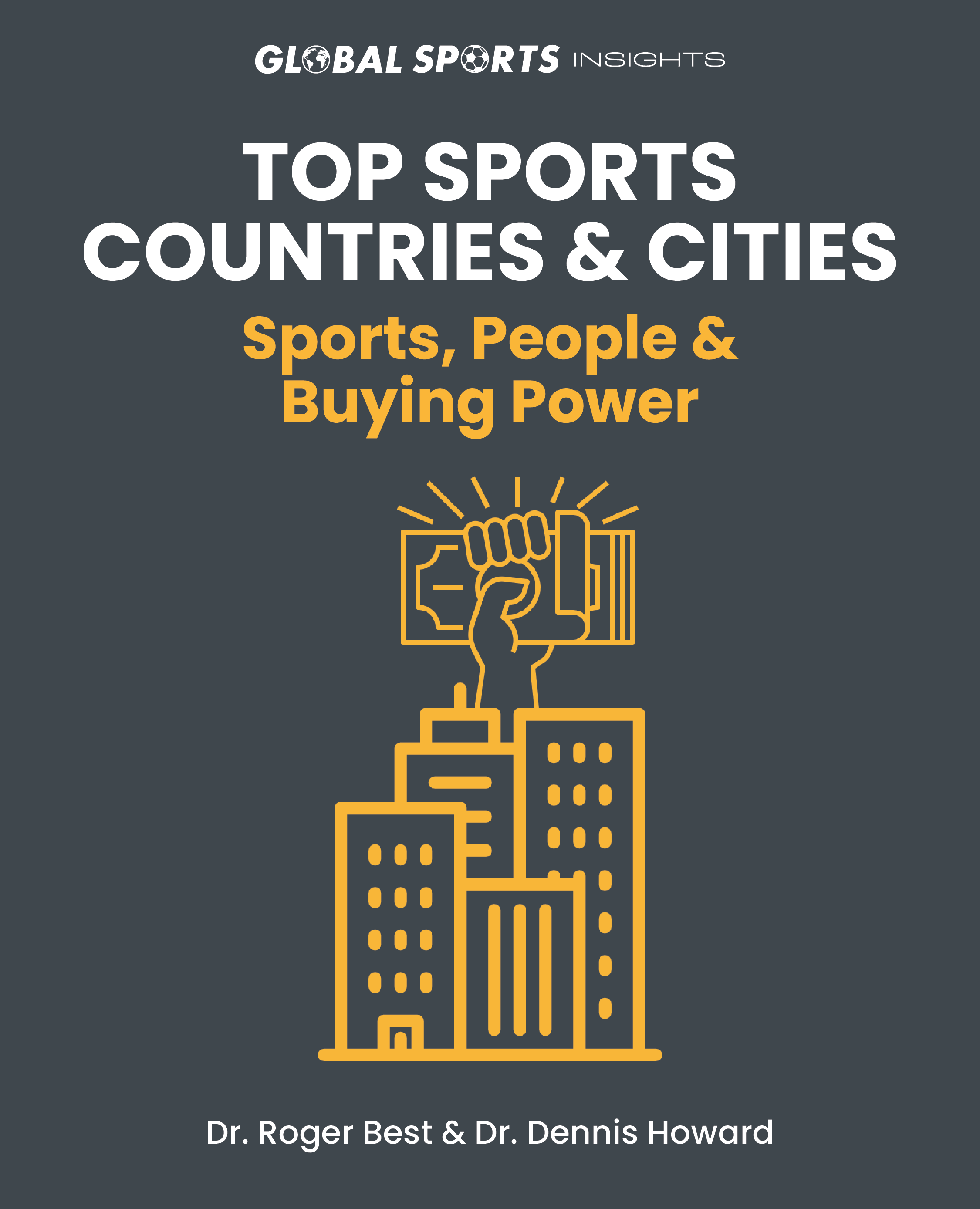
About this Report
As businesses in the sports industry begin to reach their sales potential in their home countries, they often look for new opportunities internationally. The effort usually starts in adjacent countries, where potential customers are relatively close by and might understand the firms’ culture and business infrastructure.
As sports industry businesses expand globally, acquiring the needed local knowledge grows increasingly difficult. A global perspective combines the global and local perspectives is essential for international sports industry business success. It is a strategy global sports brands must employ to adapt to local needs and marketing strategies.
This sports industry report includes two parts – Sports Countries & Sports Cities as summarized below.
Top 10 Sports Countries – The biggest challenge to companies thinking globally is seeing the world outside their country and region. Each country has a different mix of pro sports and passion for these sports. Of course, larger countries with strong economies will produce more sports revenues than smaller countries with less buying power.
We will examine the top 30 sports countries with respect number of pro teams, number of households and consumer spending to create a Country Sports Score. Using this score that ranges from zero to 100, we will list the top 10 sports countries as well as examine the correlation with a country’s sports score and purchases of sports products. This offers an excellent guide into a countries sports culture and how to position a company wanting to compete in that country’s sports industry.
Top 50 Sports Cities – Cities with more professional sports teams, more households, or greater consumer spending can generate higher levels of sports business revenues than cities with fewer pro teams, small er populations and less consumer spending.
We will examine over 100 top sports cities with respect number of pro teams, number of households and consumer spending to create a City Sports Score. Using this score that ranges from zero to 100, we will list the top 50 sports countries as well as examine their unique sports culture and sports business revenue potential.

Sports Industry Report
Contents
CONTENTS
Sample Page 1
Global Perspective

Global Perspective
As businesses in the sports industry begin to reach their sales potential in their home countries, they often look for new opportunities internationally. The effort usually starts in adjacent countries, where potential customers are relatively close by and might understand the firms’ culture and business infrastructure.
A global presence alone does not guarantee business success, local knowledge is also necessary (Figure I). A German sportswear company, for example, might first seek new customers in France. A Japanese baseball equipment firm might move into South Korea in the Asia-Pacific region. In both cases, the company has a good chance of learning the local behaviors, lifestyles, and preferences in the nearby countries and major cities that may be new product markets.
As sports industry businesses expand globally, acquiring the needed local knowledge grows increasingly difficult. The German sportswear company must expend considerably more effort to gain the local knowledge necessary to enter an Asia-Pacific country like China than it does to enter European countries. The more distant a country, language, or culture from a business’s own, the more challenging it is to achieve local success there. The further a business moves along the curve in Figure I, the greater the challenge to expand into more distant international markets and the more difficult the task of adapting to local cultures, lifestyles, and economic conditions.
A global perspective combines the global and local perspectives is essential for international sports industry business success (1). It is a strategy global sports brands must employ to adapt to local needs and marketing strategies aimed to:
• Maintain global brand image and messaging.
• Adapt to the needs, languages, and lifestyles of local cultures.
• Adapt to new marketing channels and trade regulations.
Copyright 2025 The Business of Sports
01
Sample Page 5
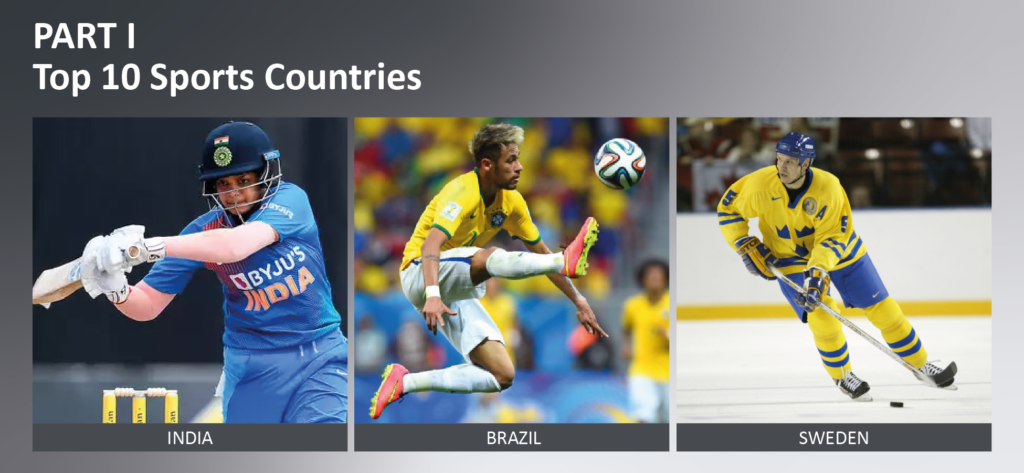
Country Sports Culture, Population & Buying Power
The biggest challenge to companies thinking globally is seeing the world outside their country and region. Each country has a different mix of pro sports and passion for these sports. Of course, larger countries with strong economies will produce more sports revenues than smaller countries with less buying power. Country sports business revenues are a function of three forces presented in Figure 1.1 and described below.
• Sports Culture: This is created by the number of professional sports teams (men and women) to drive interest, spending, and sports participation.
• Population: A country’s population, households, and age structure shape a country’s potential for sports fans and the purchase of sports products.
• Buying Power: The ability of country consumers to spend money on sports events and products and engage in sports is shaped by its Gross Domestic Product, Disposable Income, and Consumer Spending.
FIGURE 1.1
Forces that Shape Country Sports Business Revenues
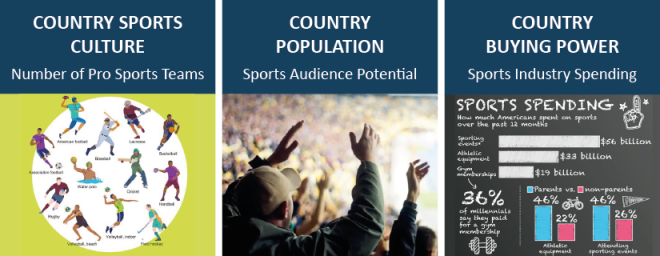
Copyright 2025 The Business of Sports
05
Sample Page 6
Top Sports Countries & Cities Report
FIGURE 1.2
Country Sports, People, Buying Power & Sportswear Revenues
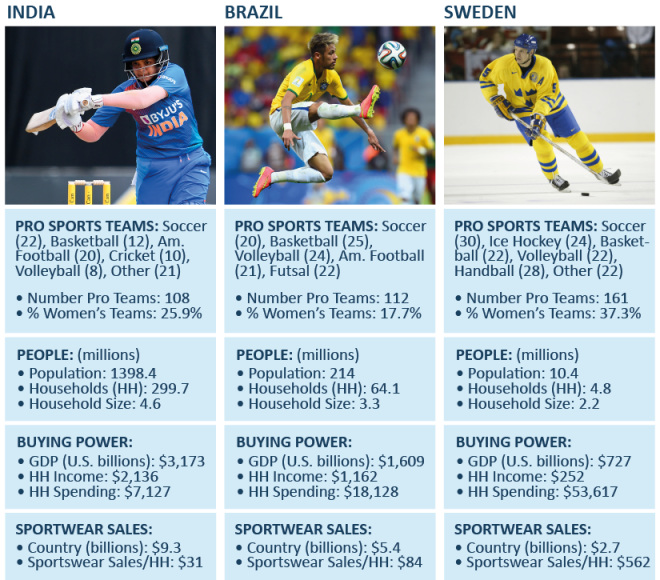
Consider, for example, countries like India, Brazil, and Norway. Each country shown in Figure 1.2 has a different number and type of pro sports teams, which shape fan engagement as well as the sports products they and the sports they participate in recreationally. While soccer, basketball, and volleyball offer many pro teams in each country, other pro-team sports shape the sports culture of that country. India has cricket and 21 other pro-team sports, Brazil is unique concerning futsal, and Sweden has ice hockey and handball.
Each country also differs in the percentage of women pro sports teams. In Sweden, 37.3% of the 161 pro sports teams are women’s teams: in India, this percentage drops to 25.9%, and in Brazil, 17.7%. This will impact how women spend money on sports business products in each country. Women’s pro team sports will create more female fan engagement, influence the purchase of sports products, and spend on sports recreation and fitness.
Sweden, the smallest country with a population of 10.4 people, has the largest number of pro sports teams (161), while India is the largest country with almost 1.4 billion people and 108 pro sports teams.
06
Copyright 2025 The Business of Sports
Sample Page 35
Top Sports Countries & Cities Report
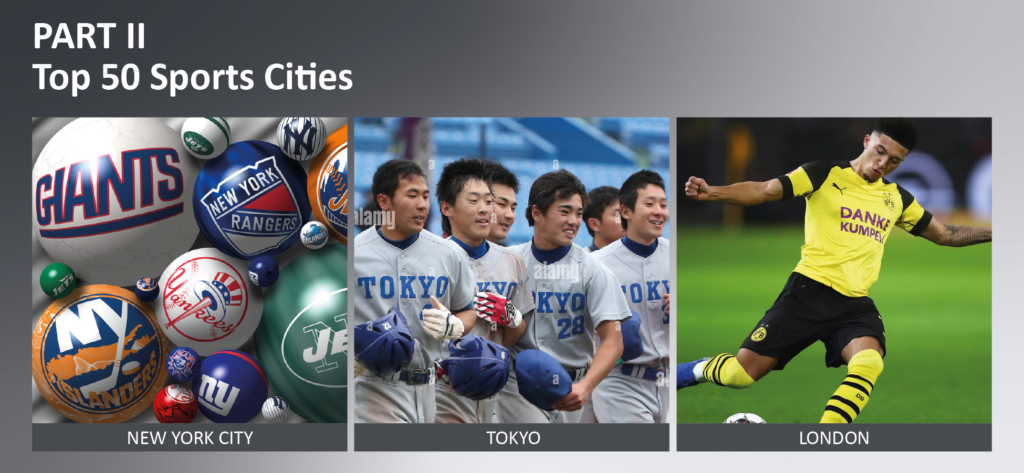
Why is New York City a Top Sports City
New York City is the top sports city in the world. Why?
New York City has 13 professional sports teams that generated over $3 billion in sales in 2022, with a city population of 20.8 million people, 7.8 million households, and nearly $1.3 trillion in consumer spending annually, as highlighted in Figure 2.1. Cities with fewer professional sports teams, fewer people, or less consumer spending cannot generate the same city sports business revenues as New York City-based on citywide spending on fan engagement, sports products, and sports participation.
City sports industry revenues are a function of three forces presented in Figure 1.1 and described below.
FIGURE 2.1
Why New York City is the Number 1 Sports City in the World
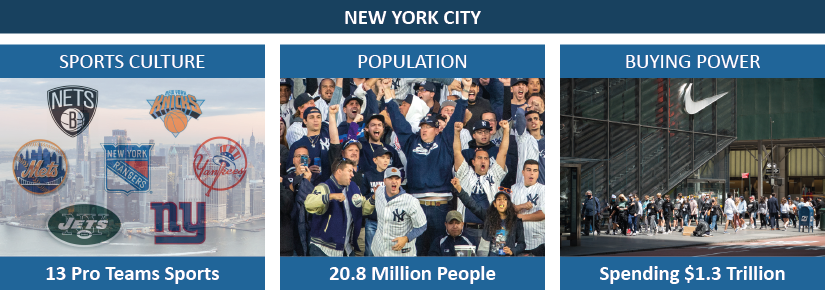
Copyright 2025 The Business of Sports
35
Sample Page 37
Top Sports Countries & Cities Report
FIGURE 2.3
Top Sports Cities Pro Sports Teams
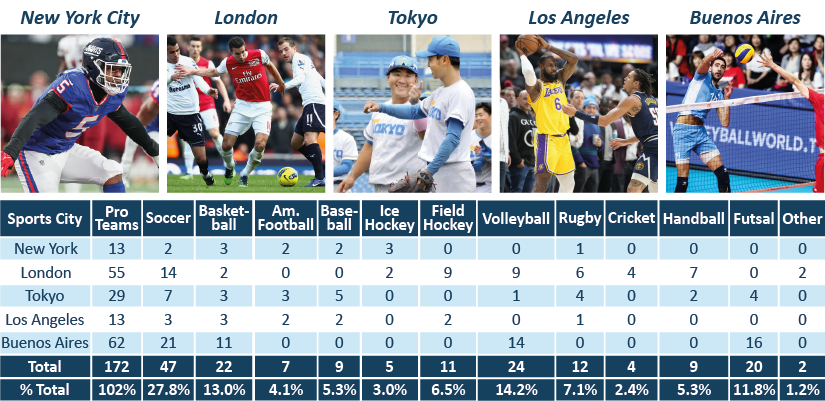
Sports offer a source of city pride. Whether the teams are perennial winners or losers, they have legacy fans built over generations (2). Some cities with multiple professional teams, large populations, and great buying power generate more sports industry revenues than entire countries. Local professional sports teams drive fan engagement, the purchase of sports products, and money spent on sports participation. Local sports media thrives on these pro sports teams, and sports entertainment, such as wagering, team merchandise retail, and sports bars, further galvanize fan engagement (3).
Sports City Personality: A combination of city culture and pro sports teams create a sports city personality unique to each sports city. These pro teams contribute to city sports personality with their team sports merchandise that further inspires a city’s street sports and fashion-inspired streetwear, as illustrated in Figure 2.5.
FIGURE 2.4
Soccer Drives the London Sports Culture
Copyright 2025 The Business of Sports
37
